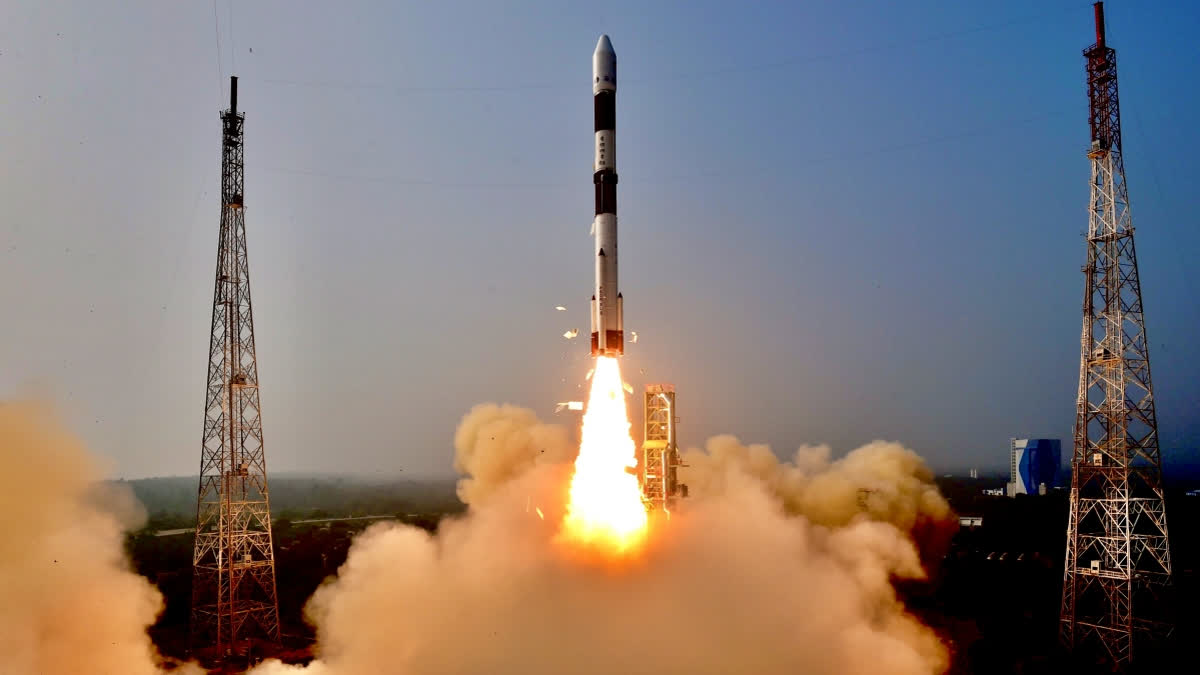Hyderabad: The year 2023 was a 'Big Bang' for Indian Space Research Organisation(ISRO) as the world witnessed India's rising prowess in the space with the triumph of soft-landing of Chandrayaan-3 to launching Aditya L1 mission, the Space agency gave several reasons to mark 2023 as the most significant year for the country.
It continued the same zeal and opened the new year 2024 on a high. On Monday, it launched XPoSat, India's first dedicated polarimetry mission to study the emission mechanism from diverse astronomical phenomena such as black holes, neutron stars, active galactic nuclei, pulsars, and nebulae, among others.
But wait, ISRO says it's just the start to the new year! There is a lot more to witness for the country and watch our space mastery rising high and high. ISRO is all set to launch three missions, poised to bring a plethora of information and insights from space, which will be valuable not only for India but for the whole world.
Three upcoming missions
1. Gaganyaan- ISRO's Gaganyaan is a crewed orbital spacecraft intended to be the formative spacecraft of the Indian Human Spaceflight Programme. The mission represents a significant leap forward in India's space capabilities.
The agency has developed a range of cutting-edge technologies, including human-rated launch vehicles and system qualifications. The mission involves approximately 20 significant tests, with three of them dedicated to crewless missions featuring the Human-Rated Launch Vehicle Mark-3 (HLVM3).
Named in Sanskrit, Gaganyaan means a craft or vehicle to the sky. The Gaganyaan mission has been developed at the cost of ₹90 billion. On the successful completion of the mission, India will join the elite list of countries comprising the Soviet Union, the US, and China, who hold the pride of sending a human into space.
The prime objective of Gaganyaan mission is to demonstrate indigenous capability to undertake human space flight missions to Low Earth Orbit(LEO). It will also lay the foundation for a sustained Indian human space exploration programme in the long run.
The mission will lead to-
- Progress towards a sustained and affordable human and robotic programme to explore the solar system and beyond.
- Advanced technology capability for undertaking human space exploration, sample return missions and scientific exploration.
- Future capability to actively collaborate in global space station development and to carry out scientific experiments of interest to the nation.
- Create a broad framework for wider academia – industry partnership in taking up development activities for national development.
- Ample scope for employment generation and human resource development in advanced science and Research and Development activities.
- Unique opportunity to inspire and excite Indian youth and steer many students toward careers in science and technology towards challenging jobs that encourage knowledge, innovation and creativity.
- The programme will strengthen international partnerships and global security through the sharing of challenging and peaceful goals. Having a vibrant human spaceflight programme can be leveraged as a potent foreign policy tool.
After the successful completion of Gaganyaan mission, ISRO's next step will focus towards achieving capability for a sustained human presence in space.
2. NISAR- NASA-ISRO Synthetic Aperture Radar (NISAR) mission is a joint collaboration between ISRO and NASA for a dual-frequency L and S-Band Synthetic Aperture Radar for earth observation.
NISAR would provide a means of disentangling highly spatial and temporally complex processes ranging from ecosystem disturbances to ice sheet collapses and natural hazards including earthquakes, tsunamis, volcanoes and landslides.
Aim and objectives of NISAR mission-
- Design, Develop and launch a Dual frequency (L and S Band) Radar Imaging Satellite.
- Explore newer application areas using L and S band microwave data, especially in natural resources mapping and monitoring;
- Estimating agricultural biomass over full duration of crop cycle;
- Assessing soil moisture; monitoring of floods and oil slicks;
- Coastal erosion, coastline changes and variation of winds in coastal waters
- Assessment of mangroves;
- Surface deformation studies due to seismic activities etc.
Who pays what? Cost of ISRO’s work share, which is estimated to be ₹788 cr while cost of NASA Jet Propulsion Laboratory(JPL) work share, which is expected to be around USD 808 millions(over ₹6,500 cr).
What do we get from the mission? NISAR would be able to collect data day and night throughout the year. The Synthetic aperture radar is highly sophisticated equipment that is used to produce extremely high-resolution images.
The satellite Earth Observatory will help in creating a data bank that will contain all the necessary information related to Earth's surface changes, natural hazards, and ecosystem disturbances.
The NISAR satellite will capture information based on two-frequency RADAR, an L-band 24-centimetre RADAR and an S-band 13 centimetre. ISRO is working on the S-band, whereas NASA is building the L-band.
Apart from the low-frequency RADAR, NASA will also provide the radar reflector antenna, the deployable boom, a high-rate communication subsystem for science data, GPS receivers, a solid-state recorder, and a payload data subsystem.
For the NISAR mission, the ISRO will provide the spacecraft bus, the launch vehicle, and the associated launch services and the satellite mission operations.
3. SPADEX -Space Docking Experiment(SPADEX) is a twin spacecraft mission being developed by the ISRO to mature technologies related to orbital rendezvous, docking, formation flying, with scope of applications in human spaceflight, in-space satellite servicing and other proximity operations.
SPADEX would consist of two IMS class-2 class (200 kg) satellites, one would be Chaser which will also be equipped with a remote robotic arm, and other being Target and both would be launched as co-passengers or auxiliary payloads. Both spacecraft would be injected into slightly different orbits.
Space Docking Experiment is currently scheduled for launch from Satish Dhawan Space Centre aboard a dedicated Polar Satellite launch Vehicle flight by the end of 2024.
SPADEX's Objectives- The primary objectives of the SPADEX mission encompass autonomous rendezvous and docking capabilities, including the unique task of controlling one spacecraft using the Attitude Control System of the other while in a docked configuration.
Furthermore, the mission aims to demonstrate formation flying techniques and conduct remote robotic arm operations, signalling a leap forward in space technology.
Current Status of SPADEX- With preliminary studies done in 2016, the Space Docking Experiment was approved by the Government of India with an initial funding of ₹10 crore cleared in 2017. In June 2019, the ISRO was looking for proposals to study remote robotic arm operation, rendezvous and docking related technologies on its PSLV fourth stage (PS4) orbital platform.
As of July 2022, Space Docking Experiment has been sanctioned ₹124.47 crore (equivalent to ₹132 crore or US$17 million in 2023) in funding and is aiming for a launch in the third quarter of 2024.



